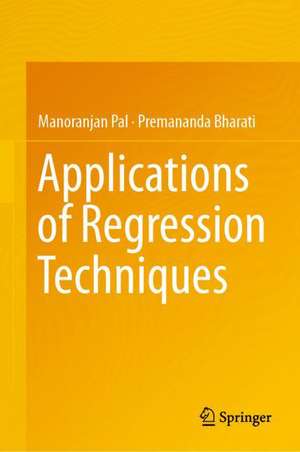Applications of Regression Techniques
Autor Manoranjan Pal, Premananda Bharatien Limba Engleză Hardback – 29 iul 2019
| Toate formatele și edițiile | Preț | Express |
|---|---|---|
| Paperback (1) | 481.58 lei 43-57 zile | |
| Springer Nature Singapore – 14 aug 2020 | 481.58 lei 43-57 zile | |
| Hardback (1) | 584.76 lei 43-57 zile | |
| Springer Nature Singapore – 29 iul 2019 | 584.76 lei 43-57 zile |
Preț: 584.76 lei
Preț vechi: 687.95 lei
-15% Nou
Puncte Express: 877
Preț estimativ în valută:
111.91€ • 116.53$ • 94.58£
111.91€ • 116.53$ • 94.58£
Carte tipărită la comandă
Livrare economică 10-24 martie
Preluare comenzi: 021 569.72.76
Specificații
ISBN-13: 9789811393136
ISBN-10: 9811393133
Pagini: 241
Ilustrații: XI, 175 p. 14 illus.
Dimensiuni: 155 x 235 mm
Greutate: 0.44 kg
Ediția:1st ed. 2019
Editura: Springer Nature Singapore
Colecția Springer
Locul publicării:Singapore, Singapore
ISBN-10: 9811393133
Pagini: 241
Ilustrații: XI, 175 p. 14 illus.
Dimensiuni: 155 x 235 mm
Greutate: 0.44 kg
Ediția:1st ed. 2019
Editura: Springer Nature Singapore
Colecția Springer
Locul publicării:Singapore, Singapore
Cuprins
Chapter 1: Introduction to Regression Analysis and an overview of the techniques used in the book.- Chapter 2: Regression Decomposition Technique towards Finding Intra-Household Gender Bias of Calorie Consumption.- Chapter 3: Estimation of Poverty Rates by Calorie Decomposition Method.- Chapter 4: Estimating Calorie-Poverty Rates through Regression.- Chapter 5: Contribution of Regressors: A Set Theoretic Approach.- Chapter 6: Estimation of Hidden Markov Chain through Regression.- Chapter 7: Finding Geometric Mean and Aggregate Growth Rate through regression.- Chapter 8: Summary and Discussions.
Notă biografică
Manoranjan Pal, former Professor at the Economic Research Unit (ERU), Indian Statistical Institute (ISI), obtained his Ph.D. in Statistics from the Indian Statistical Institute. He has held visiting faculty positions at academic and government institutions in various countries, including the National Statistical Office of Mongolia; South Asia Institute (SAI), University of Heidelberg, Germany; Centre for Operations Research and Econometrics (CORE), Louvain la Neuve University, Belgium; Institute of Mathematical Sciences, Faculty of Science, University of Malay, Malaysia; and the Department of Statistics, Rajshahi University, Bangladesh. He was Member Secretary of the International Statistical Education Centre for more than ten years. He has published over 100 research papers in reputed national and international journals and books. His research interests include measurement of poverty, inequality and segregation, applied econometrics, measurement of health and nutrition status, gender bias and empowerment of women.
Premananda Bharati, former Professor at the Indian Statistical Institute, obtained his Ph.D. in Anthropology from the University of Calcutta. He has extensive teaching experience, including teaching courses in Anthropology to graduate and postgraduate students at the Indian Statistical Institute and other universities, including institutes abroad. He is an examiner and paper setter in Anthropology for various universities, and reviews papers for a number of journals. He has published more than 100 papers in reputed national and international journals. His research interests include nutrition and health, anthropometry, empowerment of women and tribal communities.
Premananda Bharati, former Professor at the Indian Statistical Institute, obtained his Ph.D. in Anthropology from the University of Calcutta. He has extensive teaching experience, including teaching courses in Anthropology to graduate and postgraduate students at the Indian Statistical Institute and other universities, including institutes abroad. He is an examiner and paper setter in Anthropology for various universities, and reviews papers for a number of journals. He has published more than 100 papers in reputed national and international journals. His research interests include nutrition and health, anthropometry, empowerment of women and tribal communities.
Textul de pe ultima copertă
This book discusses the need to carefully and prudently apply various regression techniques in order to obtain the full benefits. It also describes some of the techniques developed and used by the authors, presenting their innovative ideas regarding the formulation and estimation of regression decomposition models, hidden Markov chain, and the contribution of regressors in the set-theoretic approach, calorie poverty rate, and aggregate growth rate. Each of these techniques has applications that address a number of unanswered questions; for example, regression decomposition techniques reveal intra-household gender inequalities of consumption, intra-household allocation of resources and adult equivalent scales, while Hidden Markov chain models can forecast the results of future elections. Most of these procedures are presented using real-world data, and the techniques can be applied in other similar situations. Showing how difficult questions can be answered by developing simple models with simple interpretation of parameters, the book is a valuable resource for students and researchers in the field of model building.
Caracteristici
Addresses various unresolved questions faced by the applied researchers Inspires researchers new to the field of model building, by showing how to develop simple models to answer difficult questions Presents techniques that are the authors’ inventions and therefore not available elsewhere
